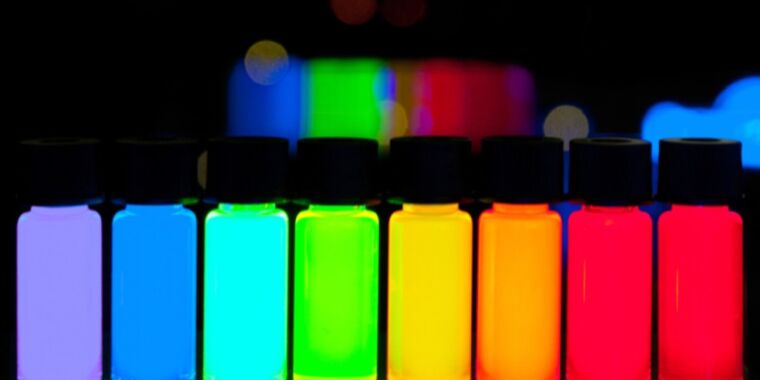
Once thought impossible to make, quantum dots have become a common component in computer monitors, TV screens, and LED lamps, among other uses. Three of the scientists who pioneered these colorful nanocrystals—Moungi G. Bawendi, Louis E. Brus, and Alexei I. Ekimov—have been awarded the 2023 Nobel Prize in Chemistry by the Royal Swedish Academy of Sciences “for the discovery and synthesis of quantum dots.” The news had already leaked in the Swedish news media—a rare occurrence—when Johan Aqvist, chair of the Academy’s Nobel committee for chemistry, made the official announcement, complete with five flasks containing quantum dots of many colors lined up before him as a visual aid.
A quantum dot is a small semiconducting bead with a few tens of atoms in diameter. Billions could fit on the head of a pin, and the smaller you can make them, the better. At those small scales, quantum effects kick in and give the dots superior electrical and optical properties. They glow brightly when zapped with light, and the color of that light is determined by the size of the quantum dots. Bigger dots emit redder light; smaller dots emit bluer light. So, you can tailor quantum dots to specific frequencies of light just by changing their size.
Physicists had thought since the 1930s that particles at the nanoscale would behave differently. That’s because, according to quantum mechanics, there is much less space for electrons when particles are that small, squeezing electrons together so tightly that material properties can change dramatically. Scientists succeeded in making nanoscale-thin films on top of bulk materials in the 1970s that had size-dependent optical properties, in keeping with those earlier predictions. But making those films required ultra-high vacuum conditions and temperatures near absolute zero, so nobody expected them to have much practical use.

Niklas Elmehed
A solution emerged from the study of ancient colored glass. Glassmakers long ago realized they could add silver, gold, or cadmium to their molten glass, vary temperature, and control the cooling process to make different shades of colored glass. Scientists later realized that the colors arose from tiny particles inside the glass, and the particular color depended on the size of those particles.
In the late 1970s, Ekimov, as a newly minted PhD, began researching the optical properties of colored glass at the S.I. Vavilov State Optical Institute in what was then the Soviet Union. He drew on some of the optical diagnostic methods he’d used for his doctoral research on semiconductors, shining light on the materials and measuring how it was absorbed to learn more about the crystal structure.
Ekimov began tinting his lab-made glass with copper chloride, X-raying the resulting glass after cooling. He found that tiny crystals of the copper chloride had formed and how he made them—varying the temperature between 500°–700° C and the heating times from one to 96 hours—affected the sizes, which ranged from about 2 nm to 30 nm. Furthermore, the particle size affected the light absorption of the glass, just like the thin films created in the 1970s: the smaller the particles, the more blue light they absorbed. These were the first quantum dots deliberately made in the laboratory.
Alas, Ekimov’s 1981 paper announcing his discovery was published in a Soviet journal, and thus, researchers elsewhere in the world didn’t have access. That included Brus, who published a 1983 paper announcing his discovery of nanoparticles floating freely in a solution that also showed size-depending optical effects.








